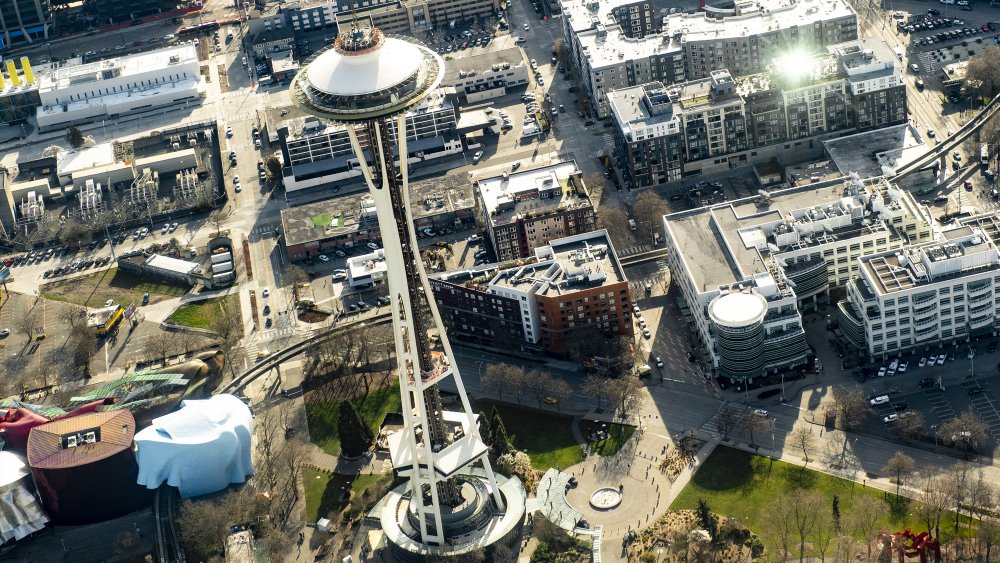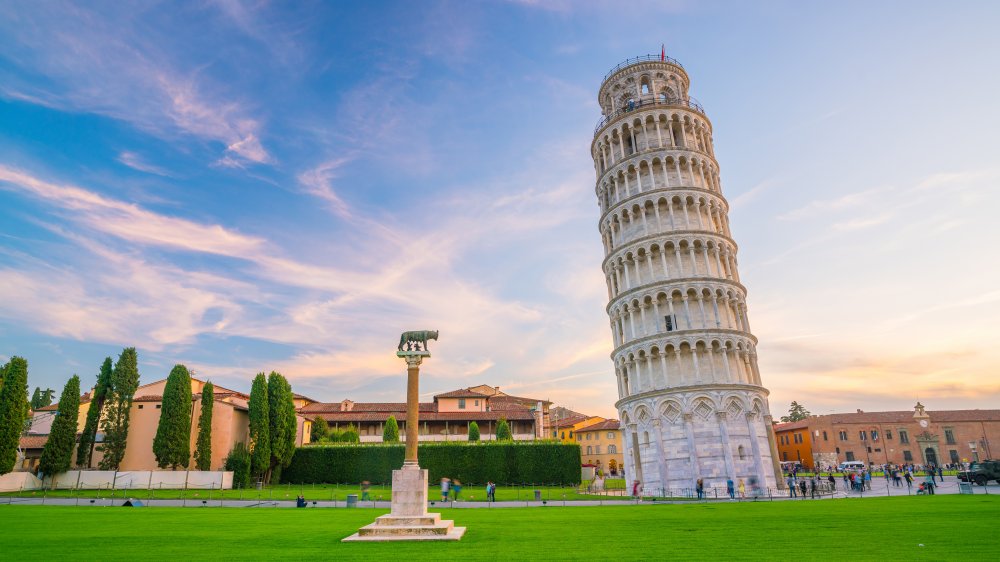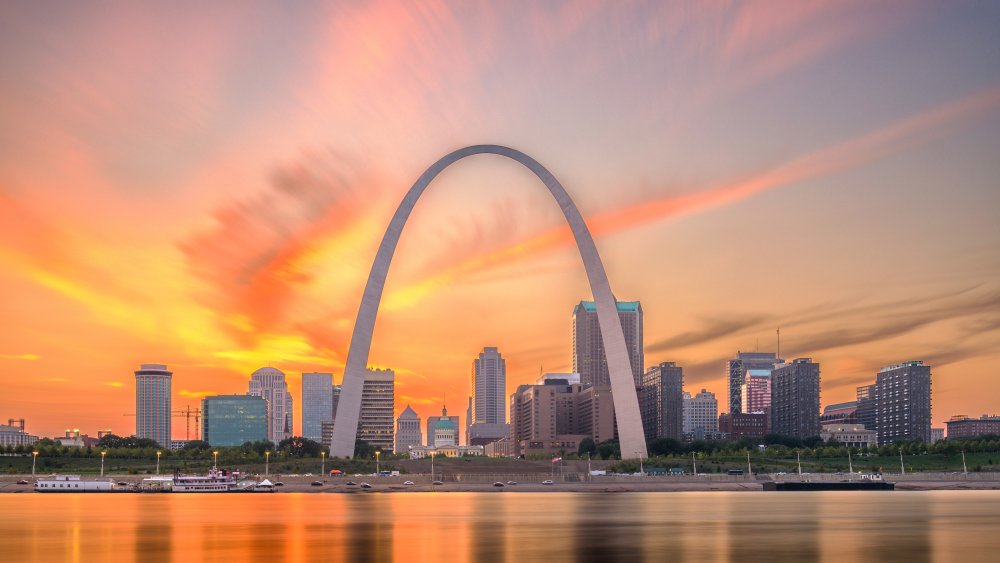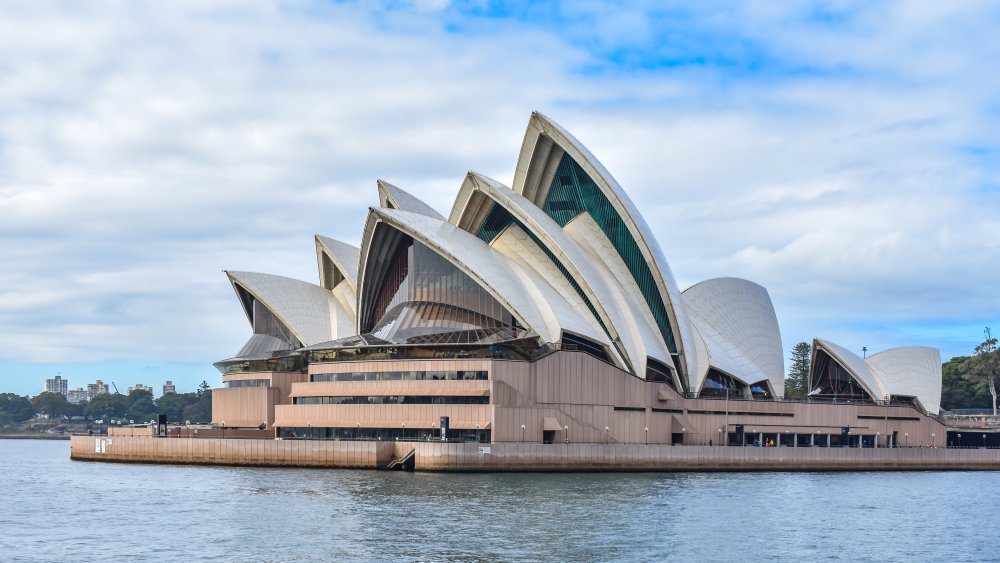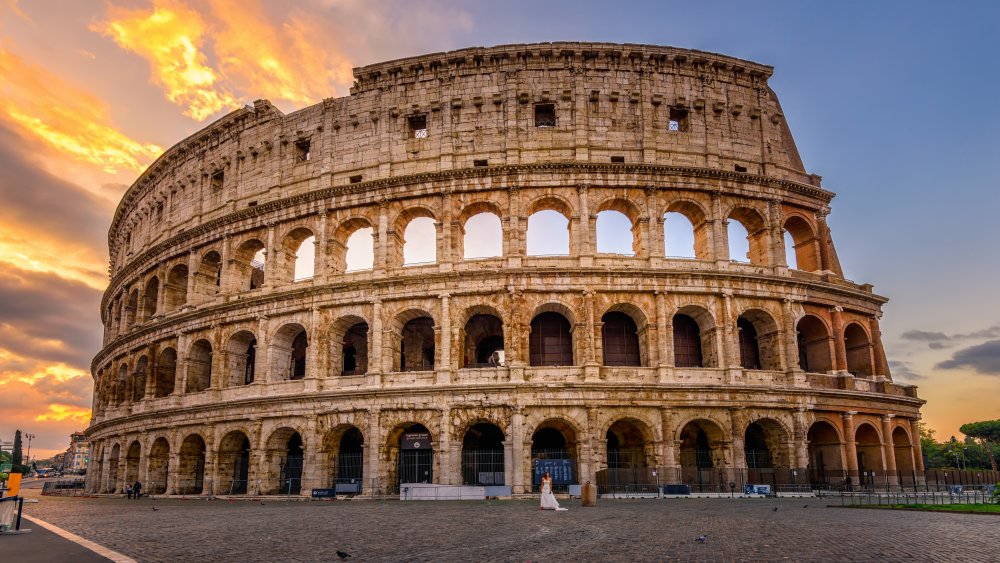How These World-Famous Structures Were Actually Built
If there's one thing you can say about human beings, it's that we sure do love to build stuff. From the simplest lean-tos out in the forest to giant mega-structures, there's no shortage of man-made creations that range from functional to purely monumental. Often enough, a building can be both, and more.
History's iconic ancient wonders of the world have slowly been expanded by dozens of incredible feats of architecture and human ingenuity from cultures all over the planet. But have you ever sat and looked at one of these structures and wondered how the heck they were made?
Much like anything created by humans, the stories behind these buildings are often dramatic, full of mistakes, and are sometimes just the result of happy accidents. From the initial designs to the finishing touches, all the things that went into the creation of these world-famous structures is nothing short of amazing.
The Golden Gate Bridge was finished early and under-budget
Building a bridge is hard work, but building one stretching across the Golden Gate Strait in San Francisco? That's in a whole other stratosphere of difficulty. This was the reality the city faced in 1916, and it looked like it couldn't be done. A bridge that long would easily cost hundreds of millions of dollars, an unthinkable sum at the time. Joseph Baermann Strauss, an engineer from Chicago, had a better idea. He presented a concept for a bridge costing less than $50 million instead, according to HowStuffWorks.
Then the waiting began. Bureaucratic delays and an angry campaign from local ferry companies held up construction until 1933. While the bridge's construction was considered a major steppingstone in safety at the time, 11 people died making it, and 19 people were only saved by a net strung under the bridge's construction. Those 19 began to call themselves the "Halfway to Hell Club."
The Golden Gate Bridge was completed in May of 1937, six months earlier than planned. Not only that, it cost $39 million, leaving it under-budget, too. As you can imagine, each of these is a rarity in large construction projects, but both early and under-budget is almost unheard of. The bridge was painted its current hue to make it more visible to ships and planes, and is actually orange, not red.
Angkor Wat was built using a clever system of canals
In 1586, a monk named António de Madalena became the first Westerner to ever set foot in a 12th century temple called Angkor Wat, in what is now the jungles of Cambodia. Not only had it never been visited by a Westerner, it was almost entirely unknown to the West, too. A Hindu/Buddhist temple dedicated to Vishnu, Angkor Wat was a massive structure, almost like a castle. It had been built by the Khmer Empire but abandoned when the Ayutthaya people to the North captured it. And, amazingly, no one really touched it for several centuries afterward. Locals knew about it, how could they not? It was huge. But it sat unused.
Surrounded by canals, the structure was built using a very efficient setup by moving huge sandstone blocks along the water to the temple site, then moving them into place from there. As a result, it took only 37 years to complete, a fraction of the time it would have taken otherwise. Not only that, but what stands today is only a small part of a city about the size of Berlin that surrounded Angkor Wat, according to the BBC.
It took several centuries, but word is now out about Angkor Wat's size and beauty. It's the largest religious structure on Earth and now has millions of visitors each year, up significantly from just the 1990s, when it only received under 10,000 visitors a year.
The Eiffel Tower was built to show off
Paris' skyline would look empty today without the Eiffel Tower, designed and built by Maurice Koechlin, Emile Nouguier, and Gustave Eiffel from 1884 to 1889. But it was, in fact, only meant to be a temporary structure for the 1889 World's Fair in Paris. Upon its construction, it was called "the ugliest building in Paris" according to LiveScience. At most, the tower was only supposed to stay up for 20 years. But over those two decades, Parisians fell in love with it and decided to keep it around permanently.
While Eiffel alone is typically credited, Koechlin and Nouguier, employees of Eiffel's company, actually came up with the initial designs for the tower. They specifically set out to build the tallest structure in the world. No building had ever reached more than 300 meters by that point, and using wrought iron in a lattice shape was key to achieving just that. It was lighter than stone, but stronger.
Eiffel and his crew were no strangers to lattice work. They had built the frame for the Statue of Liberty 20 years before, and so the construction began in 1887. After its completion, people balked at the fact that the tower served no real purpose, but it's now one of the biggest tourist attractions worldwide. So take that, grumpy late-19th century Parisians.
The Space Needle's original design was sketched on a napkin
The most iconic building in Seattle, Washington is its Space Needle, a 600-foot-tall tower that looks like a UFO with some very comically large landing gear. But the story of its creation is almost as unusual as its design. In fact, its initial design wasn't by an architect or engineer, but a hotel magnate and chairman of the 1962 World's Fair named Edward E. Carlson. Carlson had no art or design background, he simply sketched a centerpiece for the fair on a napkin in 1959, according to PBS.
He then partnered with designer John Graham, who polished up the concept. Carlson originally wanted something like a balloon tethered to the ground. Graham had the idea for it to look like a flying saucer instead, and added the unique base to it, as opposed to the simple tether Carlson had in mind. Construction began in 1961 to have the structure ready for the fair the following year.
George Gulacsik, a photographer hired to document the build, snapped pictures across the 400-day construction, revealing the process was wildly unsafe, like something out of an over-the-top job safety video. Workers walked on wooden planks hundreds of feet in the air, no handrails or safety equipment, nada. Astonishingly, no one died during construction, but to say safety standards are now far stricter is an understatement.
The Leaning Tower of Pisa took 200 years to complete
The Leaning Tower of Pisa is a wildly popular landmark both because of its tilt and in spite of it. Construction began in 1173 and it was meant to be a bell tower for the cathedral next to it. It was intended to be eight stories tall, but after five years and only two floors complete, the builders had a big problem — the tower was starting to tilt. So the Leaning Tower pretty much always had a lean.
Because the foundation only went three meters into ground that later turned out to mostly be clay, sand, and shells, it wasn't strong enough to remain upright. Around this same time, Pisa and its neighbor Genoa went to war, so construction was abandoned for a century. When construction resumed, engineer Giovanni di Simone attempted to correct the tilt by adding extra weight to one side, but this had the opposite effect and made it sink further.
The tower was completed by 1370, according to History, but it continued to sink. This was made even worse in 1838 when an architect named Alessandro Della Gherardesca decided to dig a tunnel beneath the tower so visitors could see the building's crooked base. It wasn't until the 2000s that engineers were able to halt any further leaning, leaving the tower stable for at least the next 200 years.
The St. Louis Arch is actually a series of triangles
The Gateway Arch in St. Louis, Missouri is one of the most unique buildings in the world. While it's 630 feet tall and made of steel and concrete, according to Wonderopolis, it's very light because, well, it's an arch and not a full building, but it's also hollow on the inside. It may not be obvious to people who have never been there, but there's actually a small, golf ball shaped tram inside you can ride to the top, where there's an observation deck.
While you might think this would make it more likely to blow over in a stiff wind, that's not the case. The Arch is actually very sturdy, and a 50 mile per hour wind will only make it sway about an inch. If that sounds alarming, keep in mind the structure is built to allow up to 18 inches of sway.
So how does one build a massive arch anyway? In 1963, construction began with two massive triangle-shaped supports, and workers built up section-by-section from there. The Arch is, in fact, one large triangle that starts at the ground, narrows at the top, and expands back out at the bottom of the other support. Its shape is actually based on a mathematical formula created by the Arch's structural engineer, Hannskarl Bandel.
The Pyramids were built with basic science
Perhaps one of the most fascinating construction projects in human history, the Pyramids of Giza are part burial chamber, part history museum, and part treasure vault. While we still don't know everything about how these incredible structures were built, we do have a pretty good idea these days, and sorry, Giorgio Tsoukalos, they were most likely not built by extraterrestrials. Nice hair, though.
The far more boring, but far more likely to be true, explanation for how the pyramids were built is pretty simple: Ramps. If you remember your physical science classes from middle school, these fellas are a form of simple machine known as an inclined plane. Basically, Ancient Egyptians most likely had ramps inside or around pyramids and used a sled and a bunch of workers to drag massive blocks up them. While this much is pretty well-accepted as fact by archaeologists, there are still a lot of unknowns, such as what the ramps were made of, how they were laid out, and just how the Egyptians were able to cut the enormous stone blocks in the first place, according to History.
Even with this system in place, though, building pyramids was still a very long and daunting task. The Great Pyramid is estimated to have taken about 20 years to build, for example.
Big Ben almost didn't exist
Everyone knows London's most famous landmark — the four faces of "Big Ben," the clock tower atop the Palace of Westminster. Its unforgettable chimes are iconic worldwide and even the shape of the tower itself is instantly recognizable. But the clock tower wasn't part of the Palace's first design. In 1834, that iteration of the Palace of Westminster, now known as the Old Palace, burned down, and an architect named Charles Barry designed the replacement. But even this revised design didn't include Big Ben at first, according to Britain Magazine.
It's worth mentioning at this point that neither the clock, nor the tower is actually named Big Ben. Big Ben is the name of the bells inside the clock tower, and Barry's redesign actually didn't even include any sort of tower at all. The clock tower was designed by Barry's collaborator, architect Augustus Pugin, and the clockwork was designed by an amateur clockmaker named Edmund Beckett Denison. The clock was finished in 1854, and Big Ben, the bells inside, were completed in 1859.
While the Palace's clock tower secured itself a place in history, Augustus Pugin actually didn't fare so well after. He was only 32 when he finished his design, but that was his final work. He died at only 40-years-old before it was completed, living out his last years in Bethlem Royal Hospital, the psychiatric facility better know as Bedlam.
Potala Palace is the highest religious building on Earth
While there are a great many palaces throughout the world, there's only one that's above 3,500 feet — Potala Palace outside Lhasa, Tibet. This enormous and beautiful structure is a Buddhist sacred site, containing the remains of several previous Dalai Lamas and entire libraries of Buddhist scrolls and writing, and it's built right on top of a huge mountain. In fact, there has been a palace there for over 1,300 years, though the current iteration of Potala only dates to 1645, being built on the site of the previous palace, according to ABC News.
Potala Palace was built by the fifth Dalai Lama to act as a residence for himself and future Dalai Lamas as well, and it remained so until 1959, when China annexed Tibet and the 14th (and current, as of 2020) Dalai Lama went into exile. While China and the Dalai Lama remain far from friendly, the Chinese government has actually maintained Potala Palace and currently operates it as a museum.
There are two massive buildings at Potala, the White Palace and the Red Palace. While the White Palace was completed in 1648, the fifth Dalai Lama didn't live to see completion of the grander Red Palace. Amazingly, both palaces were built in only a decade, which is pretty incredible when you consider the stone and wood used to construct each building had to be hauled up the mountain by workers.
The Sydney Opera House nearly didn't get finished
The Sydney Opera House is one of the most instantly recognizable buildings in the world, but it very nearly didn't get built at multiple points along its journey. Spearheaded by the Premier of New South Wales, Joseph Cahill, construction on the opera house began in 1959, and problems started cropping up basically right away. The construction site was found not to be settled on sandstone, as originally believed, but was actually loose alluvial deposits, which would never hold the weight of the building as designed. This was fixed by boring 700 concrete pillars into the ground, according to the Sydney Opera House.
Perhaps the bigger problem was the builders didn't actually know how much it would weigh, because its one-of-a-kind roof was still being designed. Premier Cahill, fearing the construction would be shut down by his political opponents, rushed ahead anyway, and when he died seven months into construction, the Sydney Opera House once again looked doomed. Cahill's dying wish was that the construction be completed.
Construction continued onward. By architect Jørn Utzon's design, the opera house was actually a set of premade pieces assembled on-site, according to ThoughtCo. A relatively inexperienced architect, Utzon quarreled with engineers about the project's design and actually quit in 1966, seven years into construction. The project (namely the interior) was completed by another designer, Peter Hill, though Utzon was brought back to work on a remodel in 1999.
The Colosseum was built to erase a hated Emperor
A building famously snubbed from the list of the Ancient Wonders of the World, the Colosseum in Rome was actually built relatively late in the Roman Empire's history. The reason for this is because there was another building that preceded it, the Domus Aurea (literally "House of Gold") built by the incredibly unpopular Emperor Nero sometime around 64 CE. You know, the guy who supposedly fiddled while Rome burned. The Domus Aurea was actually built after the fire, so it could have stayed up, but Nero's successor, Emperor Vespasian, opted instead to tear down the building, drain its man-made lake, and then create something new, according to Interesting Engineering.
The Colosseum was named after The Colossus, a massive statue that originally depicted Nero and stood on the site but was later modified to represent the Roman god Sol instead. Vespasian himself didn't live to see the Colosseum finished. His son, Emperor Titus, oversaw its completion. Amazingly, though, historians have no idea who the architect was responsible for the Colosseum's design. It could have been one person or several, and we just plain don't know.
Also of note with the Colosseum is that it was one of the first free-standing amphitheaters in the world. Instead of being built into a hill or other natural feature, the Colosseum managed by just being enormous and made of special Roman concrete.
The Dome of the Rock has been modified over and over
Perhaps one of the most controversial buildings in the world today, The Dome of the Rock in Jerusalem is built on a site sacred to each of the three Abrahamic religions, the Temple Mount in Jerusalem, which is claimed to be the location of both Solomon's and Herod's temples. Since there's a lot of history between Judaism, Christianity, and Islam, the shrine there is a source of much contention, as you can imagine.
The Dome of the Rock was constructed at the behest of Abd al-Malik around 687 CE as a shrine for pilgrims who visited the city, according to the Metropolitan Museum of Art. While its construction was fairly simple, an octagon capped with a dome, the building has been modified numerous times throughout the centuries as it has changed hands due to the constant battles over the area, according to Rebuild the Middle East.
The titular dome has been replaced or rebuilt many, many times due to earthquakes and war. The original dome lasted until 1057 when it collapsed due to an earthquake. Neither the original dome or its replacement was the famous gold sheen that it is today, however. That was added in the 1960s. Still, the monument has moved between a number of groups throughout the centuries, including the Crusaders and the Ottoman Empire, with each putting its own various touches on it, making it truly one-of-a-kind.




